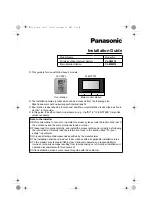
Appendix: Acoustics
Dynaudio Professional AIR reference manual – 2014-09-28
111
Standing waves
Standing waves exist in all kind of rooms. Important
parameters that will determine the frequencies around
which the phenomenon exists as well as the distribution
of these standing waves are the shape of the room, the
dimensions of the room, and the relationship between
the dimensions of the room.
How do standing waves occur?
Imagine a sound source. When a sound is emitted, the
sound wave will propagate in all directions if no obsta-
cles in sight. This will of course happen with the speed
of sound.
Now, if the sound source is placed inside a room, the
sound wave will hit the boundaries of the room. If the
boundaries consist of acoustically hard (reflective) sur-
faces, the sound is reflected. If the angle of incidence
is 90º, the sound will be reflected right back where it
came from. Under certain circumstances – for instance
if the sound is reflected between two parallel walls –,
the sound wave will meet itself again. This becomes a
problem when the sound wave not only meets itself, but
when it meets itself
in phase
. And this will happen when
the distance between the walls is half a wavelength of
the radiated sound wave. Or one whole wavelength – or
1.5, 2, 2.5 and so on.
This phenomenon is called standing waves. Actually,
the sound wave is not “standing”. But it is experienced
as that because the sound pressure maxima and mini-
ma are located in fixed places in the room.
Fig. 65: The sound field is initially radiated exposing
a radial wave front – but within a few reflections, the
sound field has obtained a plane wave front.
Room modes
These special frequencies are also called room modes.
Standing waves between parallel walls are called
axial
modes
. Other modes exist – for instance,
tangential
modes
and
radial modes
(see the following illustra-
tions). Normally, the axial modes are the strongest.
Fig. 66: Room modes: Axial modes
Fig. 67: Room modes: Tangential modes
Fig. 68: Room modes: Radial modes
Standing waves are characterized by having a maxi-
mum sound pressure at the boundaries of the room.
Depending on the frequency there are one or more dips
across the room.
Summary of Contents for AIR 15
Page 1: ...Dynaudio Professional AIR Reference manual 2014 09 28 ...
Page 7: ... Before you begin Dynaudio Professional AIR reference manual 2014 09 28 4 Before you begin ...
Page 10: ... The AIR concept Dynaudio Professional AIR reference manual 2014 09 28 7 The AIR concept ...
Page 32: ... AIR setups Dynaudio Professional AIR reference manual 2014 09 28 29 AIR setups ...
Page 66: ... AIR Remote Dynaudio Professional AIR reference manual 2014 09 28 63 AIR Remote ...
Page 85: ... Cables Dynaudio Professional AIR reference manual 2014 09 28 82 Cables ...
Page 88: ... Presets Dynaudio Professional AIR reference manual 2014 09 28 85 Presets ...
Page 90: ... Reset procedures Dynaudio Professional AIR reference manual 2014 09 28 87 Reset procedures ...
Page 92: ... Error messages Dynaudio Professional AIR reference manual 2014 09 28 89 Error messages ...
Page 94: ... Warranty Dynaudio Professional AIR reference manual 2014 09 28 91 Warranty ...
Page 126: ... Links Dynaudio Professional AIR reference manual 2014 09 28 123 Links ...
Page 128: ... Links Dynaudio Professional AIR reference manual 2014 09 28 125 ...
















































